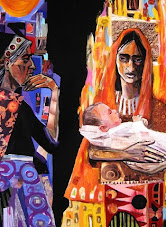 The first story in Tales of A Korean Grandmother is entitled “The House of Kim.” It is a story that contrasts gender differences:
The first story in Tales of A Korean Grandmother is entitled “The House of Kim.” It is a story that contrasts gender differences:The Korean grandmother sat comfortably on the soft tiger-skin rug, enjoying the autumn breeze that drifted in through the open door. . . . She puffed contentedly at her long pipe. . . .
“It is good to be born a boy like Yong Tu,” Ok Cha said wistfully, coming to sit down at her grandmother’s side. The little girl envied her brother—not because he was the oldest son of their father and thus one day would become, like him, Master of the House, but just because Yong Tu was a boy. He could do so many things that were not permitted then to girls in Korea. He could walk on the stret. He could picnic on the hills in the spring, or fly kites out there when the winter winds blew. He could even go with his father or the servants to buy toys in the markets and shops of the city.
Ok Cha, now that she was a full eight years old, would not be allowed to set foot outside the Inner Court. She would not see the city streets. . . . When she was married, she would only exchange the Inner Court of her father’s house for that of her husband.
That is a tale of a Korean granddaughter. But similar stories can be told in cultures around the world, America included.
A TALE OF TWO TEXAS BAPTISTS
 During most of the first half of the twentieth century, John Franklyn Norris (1877-1952) was the minister of the Fort Worth, Texas, First Baptist Church, known as the “home of the cattle kings” and the richest church in Texas (with a sister church in Detroit, and a total membership of some twenty-five thousand).
During most of the first half of the twentieth century, John Franklyn Norris (1877-1952) was the minister of the Fort Worth, Texas, First Baptist Church, known as the “home of the cattle kings” and the richest church in Texas (with a sister church in Detroit, and a total membership of some twenty-five thousand). When his efforts to shut down a house of prostitution failed, he began advertising his Sunday evening sermons as forums for exposing the names of clients. Crowds overflowed the auditorium and a tent was erected. The mayor ordered the tent removed, leading to a prolonged conflict between mayor and preacher and their supporters. Then in February of 1912, the church was burned to the ground and a month later the Norris home was burned. The mayor was blamed, but Norris, (rumored to have planned the arson in order to blame others) was the primary suspect but never charged. Another conflict erupted in 1925 when Norris sought to subvert a land purchase sought by local Catholics. A city hall official came to Norris’s office, and, according to Norris, threatened him. Norris pulled out his gun, fired four shots, and killed the man. He claimed self-defense and the jury agreed. He was found “not guilty.” Other Baptists were embarrassed by his behavior and parted company with him, but his radio audience grew as he increased his attacks against Catholics, communists, and organized labor. His influence impressed politicians including Herbert Hoover who invited him to attend his inauguration in 1929. Norris stands out as the premier fighting fundamentalist of the 1920s.
Growing up in the shadow of the First Baptist Church of Fort Worth and its notorious minister, Tillie Burgin’s sense of calling was very different from any that Frank Norris may have claimed. Her gender prevented her from being a minister. But she could take up the mantle of other Baptist women and become a missionary. Indeed, she served for several years in Korea and then returned home to Arlington, struggling with health issues and loneliness.

But the call to missions did not die. I pick up her story from an article by Eric Swanson:
As Tillie saw the needs around her, she asked herself the question, "Why can't we treat Arlington as a mission field?" And so she did. Her mission was simple--take the church to the people who were not going to church--"to hang out and hover around John 3:16."
Today, Mission Arlington is a house church movement of nearly 250 community house churches (and nearly 4,000 in attendance) serving thousands of people a week in the Arlington community with food, clothing, furniture, medical and dental care, school transportation, child and adult day care, counseling, etc.
Although the square block ministry center is bourgeoning with love and compassion, the real ministry takes place in the 250 house churches scattered in homes and apartments around Arlington. . . . .
Each day hundreds of people come through the center with various types of needs. . . . Then, these folks are followed up through the geographically located [house] churches. Last Thanksgiving, Mission Arlington fed 9,000 people in their homes, having realized that people would rather eat with their families and friends than in a center somewhere. . . .
Good deeds have become the bridge over which the good news travels. Mission Arlington sees hundreds of people come to Christ each year. Lives are being touched. Lives are being changed. Many who have come to a saving knowledge of Jesus Christ through the ministry of Tillie now serve as volunteers. Mission Arlington is a model of community involvement leading to spiritual and societal transformation.
Two twentieth-century Texas Baptists. Both seeking to serve God. Two true stories. Two parables. Jesus asks for a verdict. Which of the two did what the Father Wanted?
A TALE OF NUMBERS
How do we define a house church and tally up the numbers? By its very nature the house church—whether in China or America—eludes statistical analysis. In a recent poll a full one-third of those questioned said they were part of one. Perhaps so, if we poll only a select segment of the population and define a house church very broadly.
So then, what is a house church? A group of people over for Bible study? A pre-dawn, pancake-house, prayer gathering? Or is a house church a very specific kind of a faith community?
Must a house church be entirely independent of a large church or denomination? Must it be officially organized? Offer and/or publicize regular meeting times? Welcome visitors? Actually meet in a house? Be neighborhood oriented? Host at least a dozen people? Uphold historically orthodox Christian beliefs? Identify itself as a house church?
Who is authorized to answer these questions? Who is the Pope of house churches? Obviously, for good reason, no one has such authority.
A recent multi-survey conducted by pollster George Barna indicated that the number of people involved in house churches varies significantly depending upon how the questions are posed.
“For instance, when house church is defined in the strictest sense—as a group that meets regularly in a non-church building, is independent of a typical church and considers itself a church—only 3 to 6 percent of respondents said they are involved.”
For our purposes we will more or less define house church by this definition—a group that meets regularly in a non-church building, is independent of a typical church and considers itself a church—thus not to be confused with a cell church or a small group which is really part of a large church or denomination, though it may be connected with other house churches as in the case of those initiated by Tillie Burgin.
My assignment for this lecture was to look at house churches historically. If definitions and statistics are difficult to pin down for the contemporary scene, multiply that many times over in assessing the historical picture.
My assignment for this lecture was to look at house churches historically. If definitions and statistics are difficult to pin down for the contemporary scene, multiply that many times over in assessing the historical picture.
I offer my overview in a 7-point outline.
1. Biblically Authentic
2. Culturally Sensitive
3. Outreach Oriented
4. Inwardly Caring
5. Lay-leadership Necessitated
6. Theologically Inclusive
7. Imaginatively Innovative
.
.
















No comments:
Post a Comment